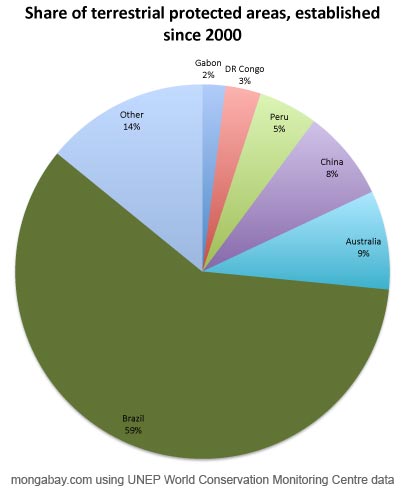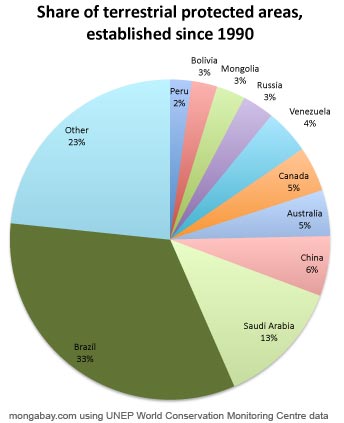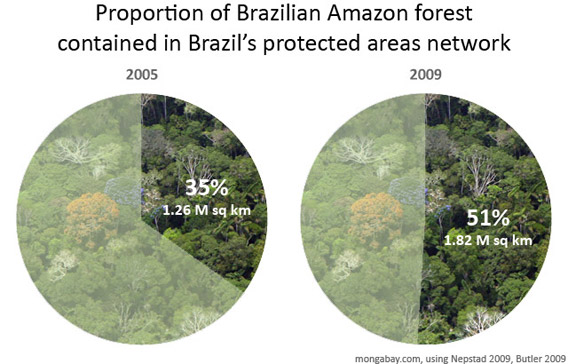Brazil set aside more land in protected areas than any other country during the 2000s, accounting for nearly 60 percent of total terrestrial conservation during the decade, according to mongabay.com’s analysis of data from the U.N Environment Program and the World Conservation Monitoring Center.
Between 2000 and 2008 (the most recent year for which data is available) Brazil established 869,360 square kilometers in new protected areas, an increase of 53 percent over 2000. Second on the list was Australia (125,128 sq km), followed by China (114,913 sq km), Peru (75,049 sq km), and Democratic Republic of Congo (44,833).
In terms of relative gain among countries with more than 5,000 sq km set aside for conservation, Gabon’s extent of protected land increased by nearly 200 percent from 15,209 sq km in 2000 to 44270 sq km, far ahead of Peru (73 percent), Myanmar (59 percent), and Brazil (53 percent).
 
|
Brazil now has the largest area of protected land (2.52 million sq km), according to the UNEP-WCMC data. It is followed by Russia (1.54 million sq km), China (1.45 million sq km), and United States (1.36 million sq km) and Greenland (864,306).
In terms of proportion of land mass under protection, at least on paper, Venezuela lists 71 percent, followed by Germany (56 percent), Estonia (47 percent), Belize (45 percent), and Zambia (41 percent).
Forest loss
Paradoxically, Brazil also lost the most forest of any country during the decade. 175,000 sq km of Amazon rainforest in Brazil was cleared in the 2000s, while an even larger area of cerrado, Brazil’s woody grassland, was lost. At least 3,000 sq km of Mata Atlantica (Atlantic Forest), Brazil’s most endangered rainforest, was also destroyed.
Deforestation rates for other countries won’t be finalized until next year but it is likely that among tropical countries, Indonesia, Myanmar, DR Congo, Tanzania, Peru, Zambia, Sudan, and Nigeria would follow Brazil in terms of forest loss.
Brazil is aiming to shed its deforestation crown next decade under its plan to reduce greenhouse gas emissions, more than 60 percent of which result from deforestation. Brazil’s targets call for roughly a 70 percent cut in deforestation rates by 2017 through increased law enforcement, paying locals to keep trees standing, providing incentives for business to be more environmentally-responsible, and establishing new protected areas. More than half the Brazilian Amazon — some 1.82 million sq km — is already under some form of protection

|
TABLES
Percent land area under protection on paper, 2008
Excludes small countries
| Country | percent | |
| Venezuela | 71.3% | |
| Germany | 56.2% | |
| Estonia | 46.7% | |
| Belize | 44.5% | |
| Zambia | 41.1% | |
| Greenland | 39.9% | |
| Tanzania | 39.1% | |
| Saudi Arabia | 38.4% | |
| Israel | 34.6% | |
| Guatemala | 32.7% | |
| Costa Rica | 31.0% | |
| Botswana | 30.1% | |
| Bhutan | 30.1% | |
| New Zealand | 29.8% | |
| Brazil | 29.6% | |
| Switzerland | 28.6% | |
| Dominican Republic | 28.5% | |
| Panama | 28.1% | |
| Austria | 28.0% | |
| Colombia | 26.2% |
Increase in protected land area, 2000-2008
| Country | sq km | |
| Brazil | 869360 | |
| Australia | 125128 | |
| China | 114913 | |
| Peru | 75049 | |
| DR Congo | 44833 | |
| Gabon | 29061 | |
| Germany | 21083 | |
| Iran | 20778 | |
| Myanmar | 16695 | |
| Egypt | 16169 | |
| Mexico | 15392 | |
| Canada | 15259 | |
| Indonesia | 11939 | |
| Tanzania | 10624 | |
| France | 8562 | |
| Mozambique | 7340 | |
| Cameroon | 7334 | |
| Romania | 7063 | |
| Paraguay | 6407 | |
| Congo | 4740 |
Total protected land area, 2008
| Country | sq km | |
| Brazil | 2524089 | |
| Russia | 1543566 | |
| China | 1452693 | |
| United States | 1358345 | |
| Greenland | 864306 | |
| Saudi Arabia | 824494 | |
| Canada | 820860 | |
| Australia | 808972 | |
| Venezuela | 650743 | |
| Tanzania | 370523 | |
| Zambia | 309052 | |
| Indonesia | 299925 | |
| Colombia | 298441 | |
| DR Congo | 273387 | |
| Bolivia | 232988 | |
| Mongolia | 217912 | |
| Germany | 200611 | |
| Ethiopia | 193671 | |
| Argentina | 180286 | |
| Peru | 177253 |
RELATED ARTICLES
Brazil could halt Amazon deforestation within a decade

(12/03/2009) Funds generated under a U.S. cap-and-trade or a broader U.N.-supported scheme to reduce greenhouse gas emissions from deforestation and degradation (“REDD”) could play a critical role in bringing deforestation in the Brazilian Amazon to a halt, reports a team writing in the journal Science. But the window of opportunity is short — Brazil has a two to three year window to take actions that would end Amazon deforestation within a decade.
Brazil’s plan to save the Amazon rainforest

(06/02/2009) Accounting for roughly half of tropical deforestation between 2000 and 2005, Brazil is the most important supply-side player when it comes to developing a climate framework that includes reducing emissions from deforestation and forest degradation (REDD). But Brazil’s position on REDD contrasts with proposals put forth by other tropical forest countries, including the Coalition for Rainforest Nations, a negotiating block of 15 countries. Instead of advocating a market-based approach to REDD, where credits generated from forest conservation would be traded between countries, Brazil is calling for a giant fund financed with donations from industrialized nations. Contributors would not be eligible for carbon credits that could be used to meet emission reduction obligations under a binding climate treaty.
How to save the Amazon rainforest
(01/04/2009) Environmentalists have long voiced concern over the vanishing Amazon rainforest, but they haven’t been particularly effective at slowing forest loss. In fact, despite the hundreds of millions of dollars in donor funds that have flowed into the region since 2000 and the establishment of more than 100 million hectares of protected areas since 2002, average annual deforestation rates have increased since the 1990s, peaking at 73,785 square kilometers (28,488 square miles) of forest loss between 2002 and 2004. With land prices fast appreciating, cattle ranching and industrial soy farms expanding, and billions of dollars’ worth of new infrastructure projects in the works, development pressure on the Amazon is expected to accelerate. Given these trends, it is apparent that conservation efforts alone will not determine the fate of the Amazon or other rainforests. Some argue that market measures, which value forests for the ecosystem services they provide as well as reward developers for environmental performance, will be the key to saving the Amazon from large-scale destruction. In the end it may be the very markets currently driving deforestation that save forests.
Corporations become prime driver of deforestation, providing clear target for environmentalists
(08/05/2008) The major drivers of tropical deforestation have changed in recent decades. According to a forthcoming article, deforestation has shifted from poverty-driven subsistence farming to major corporations razing forests for large-scale projects in mining, logging, oil and gas development, and agriculture. While this change makes many scientists and conservationists uneasy, it may allow for more effective action against deforestation. Rhett A. Butler of Mongabay.com, a leading environmental science website focusing on tropical forests, and William F. Laurance of the Smithsonian Tropical Research Institute in Panama believe that the shift to deforestation by large corporations gives environmentalists and concerned governments a clear, identifiable target that may prove more responsive to environmental concerns.